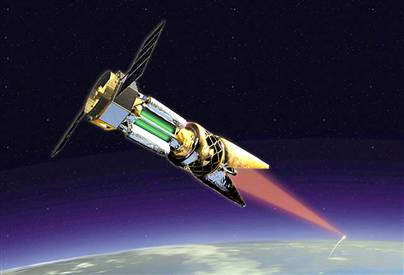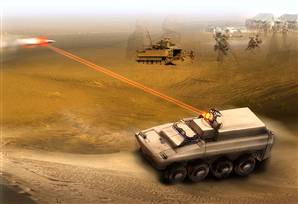

By Leonard David (See also Weapons In Space at bottom of this page.
Directed-energy weapons take the form of lasers, high-powered microwaves and particle beams. Their adoption for ground, air, sea, and space warfare depends not only on using the electromagnetic spectrum, but also upon favorable political and budgetary wavelengths too. That's the outlook of J. Douglas Beason, author of the recently published book "The E-Bomb: How America's New Directed Energy Weapons Will Change the Way Wars Will Be Fought in the Future." Beason previously served on the White House staff working for the president's science adviser under both the Bush and Clinton administrations. After more than two decades of research, the United States is on the verge of deploying a new generation of weapons that discharge beams of energy, such as the Airborne Laser and the Active Denial System, as well as the Tactical High Energy Laser, or THEL. "History has shown that, without investment in high technology, fighting the next war will be done using the 'last war' type of technique," Beason told Space.com. Putting money into basic and long-range research is critical, Beason said, adding: "You can]t always schedule breakthroughs." A leading expert in directed-energy research for 26 years, Beason is also director of threat reduction here at the Los Alamos National Laboratory. However, he noted that he was expressing his own views rather than the policy of the laboratory, the Defense Department or the Energy Department. Ripe for transformation? Though considerable work has been done in lasers, high-power microwaves and other directed-energy technologies, weaponization is still an ongoing process.
Similarly, testing of the U.S. Army's Tactical High Energy Laser in White Sands, N.M., has shown the ability of heating high-flying rocket warheads, blasting them with enough energy to make them self-detonate. THEL uses a high-energy, deuterium fluoride chemical laser. A mobile THEL also demonstrated the ability to kill multiple mortar rounds. Then there's Active Denial Technology ã a non-lethal way to use millimeter-wave electromagnetic energy to stop, deter and turn back an advancing adversary. This technology, supported by the U.S. Marines, uses a beam of millimeter waves to heat a foeπs skin, causing severe pain without damage, and making the adversary flee the scene. Beason also pointed to new exciting research areas underway at the Los Alamos National Laboratory: Free-electron laser work with the Navy and a new type of directed energy that operates in the terahertz region. Niche for new technology While progress in directed-energy is appreciable, Beason sees two upfront problems in moving the technology forward. One issue has to do with "convincing the warfighter that there's a niche for this new type of weapon," and the other relates to making sure these new systems are not viewed as a panacea to solve all problems. "They are only another tool," he said.
This is a conceptual look at putting a solid-state laser on an armored ground combat vehicle for potential use in the U.S. militaryπs Future Combat Systems program (pictured right). Looming even larger is the role of those who acquire new weapons. "The U.S. could put ourselves in a very disastrous position if we allow our acquisition officials to be non-technically competent," Beason explained. Over the decades, Beason said that the field of directed-energy has had its share of "snake-oil salesmen", as well as those advocates who overpromised. "It wasn't ready for prime time." At present, directed-energy systems "are barely limping along with enough money just to prove that they can work," Beason pointed out. Meanwhile, huge slugs of money are being put into legacy-type systems to keep them going. "It's a matter of priority," Beason said. The time is now to identify high-payoff, directed-energy projects for the smallest amounts of money, he said. Unknown unknowns In Beason's view, Active Denial Technology, the Airborne Laser program and the THEL project, as well as supporting technologies such as relay mirrors, are all works in progress that give reason for added support and priority funding. "I truly believe that as the Airborne Laser goes, so goes the rest of the nation's directed-energy programs. Right now, it's working on the margin. I believe that there are still 'unknown unknowns' out there that are going to occur in science and technology. We think we have the physics defined. We think we have the engineering defined. But something always goes wrong ä and we're working too close at the margin," Beason said. Stepwise demonstration programs that spotlight directed-energy weapon systems are needed, Beason noted. Such in-the-field displays could show off greater beam distance-to-target runs, mobility of hardware, ease-of-operation, battlefield utility and other attributes. Directed-energy technologies can offer a range of applications, from botching up an enemy's electronics to performing "dial-up" destructive strikes at the speed of light with little or no collateral damage. Beason said he has a blue-sky idea of his own, which he tags "the voice from heaven." By tuning the resonance of a laser onto Earthπ' ionosphere, you can create audible frequencies. Like some boom box in the sky, the laser-produced voice could bellow from above down to the target below: "Put down your weapons." Relay mirrors Regarding use of directed-energy space weapons, Beason advised that "we'll eventually see it." However, present-day systems are far too messy. Most high-powered chemical lasers -- in the megawatt-class -- require onboard fuels and oxidizers to crank out the amount of energy useful for strategic applications. Stability of such a laser system rooted in space is also wanting. On the other hand, Beason said he expected to see the rise of more efficient lasers ã especially solid-state laser systems. "What breakthroughs are needed ä I'm not sure. Eventually, I think it's going to happen, but it is going to be a generation after the battlefield lasers." Shooting beams "through space" is another matter, Beason quickly added. Space-based relay mirrors -- even high-altitude airships equipped with relay mirrors -- can direct ground-based or air-based laser beams nearly around the world, he said. "So you're using space ä exploiting it. But you are going through space to attack anywhere on Earth," Beason said. History lesson Late last year, speaking before the Heritage Foundation in Washington, Beason told his audience that laser energy, the power sources and beam control, as well as knowledge about how laser beams interact with Earth's atmosphere, are quite mature technologies that are ready for the shift into front-line warfare status. "The good news is that directed energy exists. Directed energy is being tested, and within a few years directed energy is going to be deployed upon the battlefield," Beason reported. "But the bad news is that acquisition policies right now in this nation are one more gear toward evolutionary practices rather than revolutionary practices." "Visionaries win wars ä and not bureaucrats. We've seen this through history," Beason observed.
Weapons in outer space
By William Marshall | July 5, 2006
TENSIONS IN the United Nations over space-based weapons ran to new heights recently when the United States delivered a hard-line statement on its right to develop such weapons.
Article Tools
Responding to repeated and increased international pressure in recent weeks, John Mohanco, US deputy director of the Office of Multilateral Nuclear and Security Affairs, said ``our government will continue to consider the possible role that space-related weapons may play in protecting our [space] assets."
Russia, which is pushing for a new treaty on such weapons, wanted countries to ``refrain from any practical activities aimed to place weapon systems in outer space while the international agreement on non-weaponization of outer space is being elaborated." Apparently the US reaction was only to harden its stance.
This adds to the alarming change of course last year when the United States became the first country to oppose the annual non binding resolution on Preventing an Arms Race in Outer Space. Essentially the world considers it important to develop a treaty to prevent an arms race in space by prohibiting weapons there. The need for a treaty is compounded by the US withdrawal in 2002 from the ABM Treaty, which had key restrictions on space weapons.
This discussion is far from theoretical: The US Air Force is pushing lasers with which to attack satellites, and the Missile Defense Agency is pushing for another budget hike for space-based weapons. Already the United States is spending hundreds of millions of dollars per year on such weapons.
Space issues are perhaps the most important Achilles' heel facing the US military. Their importance can be seen from Iraq: Planning and operations are helped by satellite imagery. Planes, ships, tanks, and even missiles are guided by the Global Positioning System. Generals command missions from outside the country thanks to communications satellites. Beyond this, early warning satellites would serve as the first notice of missile attacks.
The problem is that satellites are also vulnerable to elimination by enemies. A Space Commission report chaired by Defense Secretary Donald Rumsfeld considers the threat so real it warned of a ``Space Pearl Harbor."
Naturally, Americans want to protect these assets, so why not pursue space weapons? The most compelling reason is that they would actually make the situation worse.
This is due to the technical ease of ground-based anti-satellite systems. Adversaries wouldn't need to go to the trouble of building space-based weapons systems. Simple and inexpensive, ground-based systems could shoot these satellites out of the sky. More than 25 nations already have the missile capability to reach the altitude at which the satellites orbit. More significantly, powerful lasers able to kill a satellite in low orbit through heating are available commercially in more than 50 nations. If the United States deploys ground-based anti-satellite technology, or ASATs (which it can do technically now), then others will follow suit. America has the most assets in orbit to lose in such a game.
If the United States deploys space-based weapons -- like interceptors for missile defense (which it is on course to deploy within about 6 years) -- an adversary could simply take them out from the ground. If any security advantage afforded by such a weapon is easily negated, then one is left with the prospect of other nations moving toward developing ground-based ASAT capabilities. This would severely jeopardize America's precious satellites, all of them. Also, the capabilities provided by each proposed space-based weapon can be achieved with ground-based alternatives that are generally 100 to 1,000 times cheaper.
In addition, the United States is planning to release a new National Space Policy within weeks, tweaks to the language of which could give the green light for US deployment of space-based weapons. Instead, the United States should send a sign to other nations by taking space-based weapons off the books once and for all. America can still protect its satellite systems -- in less-threatening ways.
Instead of having a space architecture that consists of a few big satellites that are complex, expensive, and difficult to replace, the United States should move to a model consisting of many inexpensive micro-satellites that offer the same capability. Other nations are already moving in that direction.
Doing nothing about the vulnerability of satellites would be a bad security decision, but weaponizing space is no solution. Doing that would be like watching brave Achilles unsheathing his knife and turning it on himself.
|
 LOS ALAMOS, N.M. - There is a new breed of weaponry fast approaching -- and at the speed of light, no less. They are labeled "directed-energy weapons," and they may well signal a revolution in military hardware -- perhaps more so than the atomic bomb.
LOS ALAMOS, N.M. - There is a new breed of weaponry fast approaching -- and at the speed of light, no less. They are labeled "directed-energy weapons," and they may well signal a revolution in military hardware -- perhaps more so than the atomic bomb.  For example, work is continuing in the military's Airborne Laser program. It utilizes a megawatt-class, high-energy chemical oxygen iodine laser toted skyward aboard a modified Boeing 747-400 aircraft. The purpose of the program is to enable the detection, tracking and destruction of ballistic missiles in the boost phase, or powered part of their flight.
For example, work is continuing in the military's Airborne Laser program. It utilizes a megawatt-class, high-energy chemical oxygen iodine laser toted skyward aboard a modified Boeing 747-400 aircraft. The purpose of the program is to enable the detection, tracking and destruction of ballistic missiles in the boost phase, or powered part of their flight.  Northrop Grumman
Northrop Grumman